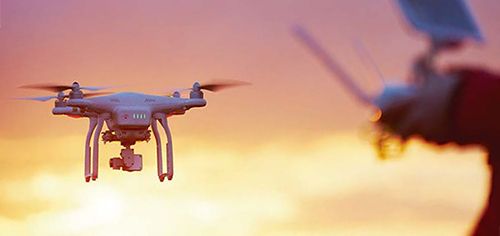With the wildfire season in full swing, the FBI has new assets in place in California for detecting, identifying and “neutralizing” drones that are illegally operated in firefighting zones. The bureau is working with the Los Angeles County Fire Department to leverage technology that can detect dangerous drone activity within 30 seconds of launch, according to the FBI.
The U.S. Forest Service reports that, in 2019, aerial firefighting operations were temporarily shut down nine times as a result of no fewer than 20 unauthorized drones detected near wildfires in seven states, including Arizona, California, Colorado, Nevada, New Mexico, Utah, Washington and Minnesota.
James Peaco III, coordinator of weapons of mass destruction for the FBI’s Los Angeles field office, told CNN, “When the detection equipment finds the drone and identifies the operator’s location, we can very rapidly get that information to a ground intercept team who can then go make contact with that drone operator and essentially get them to stop flying that drone. The first thing we do is order them to bring the drone back, explain that there’s a wildfire and flying that drone during a wildland fire is actually a federal felony.”
Special sensors establish a boundary and track any intruding drone’s departure point, altitude, heading and speed as well as the controller’s current location, Peaco said.
Interfering with firefighting operations on public lands is a federal crime punishable by up to 12 months in prison. And the FAA is authorized by Congress to levy a civil penalty of up to $20,000 on drone pilots who interfere with operations involving wildfire suppression, law enforcement or emergency response.




































Excellent.
Police forces will want that, voters need to ensure they elect officials who support police with funding.
(No reports I’ve heard of UAVs in air over:
– the mass shooter tragedy in Nova Scotia, police could have used one with IR sensor as they managed to have both of their aircraft in maintenance and use of the big SAR helo had to be blessed through channels. The perp’s killing spree begain in the night, police did get a civilian helo in the morning
– bank robbery shootout in Saanich BC, there was a helo overhead at one point, probably an RCMP help that brought explosives handling team from the mainland
Three months to TossEmTime in BC, fire scummy politicians.
Presumably they are using airborne tracking receivers that depend on receiving & decoding the UAV and controller’s transmissions, which in turn would rely on standardized formats & frequency band. OK for off-the-shelf hardware, I guess, but I suspect a motivated operator with a bit of research & effort likely would be able to evade the system. Tech warfare.
BTW, I think having a business card title like Peaco’s “Coordinator of Weapons of Mass Destruction” would be pretty cool.
Your presumption is wrong. You don’t need to decode a radio signal to find the location it’s being sent from.
Some of the systems use tripod-mounted ground based directional microwave receivers to detect the signal from the UAV. The more receivers, the more accuracy. Some systems also have the ability to launch UAVs to disable the intruding UAV. I looked into these systems when I was flying a scout plane on forest fires for a state forest service.
Don’t tell the Russians about the tracking technology. Civilian drone operators in Ukraine have been very helpful to their military in spotting Russian troop positions and the movements of enemy tanks and heavy equipment.